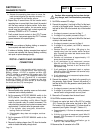
b. Actuate the operating lever down to move the
load contacts against the standby contacts, i.e.,
load connected to the Standby source.
6. Repeat Step 5 several times. As the transfer switch
operating lever is moved slight force should be needed
until the lever reaches its center position. As the lever
moves past its center position, an over-center spring
should snap the moveable load contacts against the
stationary STANDBY or UTILITY contacts.
7. Finally, actuate the main contacts to their UTILITY power
source side, i.e., load contacts against the UTILITY contacts
(upward movement of the operating lever).
RESULTS:
1. If there is no evidence of binding, sticking, or excessive
force required, refer back to flow chart.
2. If evidence of sticking, binding, excessive force required
to move main contacts, find cause of binding or sticking
and repair or replace damaged part(s).
TEST 28 – CHECK 23 AND 15B WIRING/
CONNECTIONS
DISCUSSION:
An open circuit in the transfer switch control wir-
ing can prevent a transfer action from occurring.
Battery voltage +12 VDC is supplied on Wire 15B.
This DC voltage is supplied to the transfer relay (TR)
at Terminal Location “A”. The opposite side of the
transfer relay (TR) coil (Terminal B) is connected
to Wire 23. Positive 12 VDC is present on this also.
Circuit board action will allow current to flow through
the circuit and the (TR) is energized.
PROCEDURE/ RESULTS:
Refer to Figure 3.
1. Remove transfer relay mounting screws so that contact
movement can be visually observed.
2. Set the generator AUTO-OFF-MANUAL switch to the
AUTO position. Turn off utility power supply to the
transfer switch, simulating a utility failure. Visually
watch the transfer relay for contact movement. The
relay should be energized and contact movement seen
approximately 10 seconds after the generator starts.
a. If the transfer relay energizes, discontinue
testing. Refer to flow chart.
b. If the transfer relay does not energize, continue
to Step 3.
3. Set the generator AUTO-OFF-MANUAL switch to the
OFF position.
4. Remove the battery charger fuse (F3) from the transfer
switch to disable the battery charge circuit.
*
Caution: After removing the fuse from the bat-
tery charger, wait 5 minutes before proceeding.
5. Set VOM to measure DC voltage.
6. Connect the negative (-) test lead to Wire 0 at the termi-
nal strip in the transfer switch. Connect the positive (+)
test lead to Wire 15B at the terminal strip in the transfer
switch.
a. If voltage is present, proceed to Step 7.
b. If voltage is not present proceed to Step 17.
7. Connect the positive (+) test lead to Wire 23 at the termi-
nal strip in the transfer switch.
a. If voltage is present, proceed to Step 8.
b. If voltage is not present, set VOM to measure
resistance.
c. Remove Wire 23 and Wire 15B going to the
transfer relay from the transfer switch terminal
strip. Connect the meter test leads across Wire
23 and Wire 15B.
d. Transfer coil resistance of approximately 115
ohms should be measured.
e. If coil resistance is not measured, remove
Wire 23 and Wire 15B from the transfer relay.
Measure across Terminal A and Terminal B of
the transfer relay.
f. If coil resistance is measured repair or replace
Wire 23 or Wire 15B between the terminal strip
and the transfer relay.
g. If coil resistance is not measured replace trans-
fer relay and retest.
8. Connect the negative (-) test lead to the ground lug in
the generator control panel. Connect the positive (+)
test lead to Wire 23 in the generator control panel at the
terminal strip.
a. If voltage is present, proceed to Step 9.
b. If voltage is not present, repair wiring between
transfer switch and generator control panel.
9. Remove the J2 connector from the circuit board.
10. Set VOM to measure resistance.
11. Connect one meter test lead to Wire 23 Pin Location
J2-5. Connect the other meter test lead to Wire 15B
Pin Location J2-8. Approximately 115 ohms should be
measured. (see Figures 4 through 7, Section 4.1).
a. If approximately 115 ohms is measured proceed
to Step 12.
b. If infinity or an open is measured, repair Wire 23
between PCB Connector J2 and the generator
terminal strip.
c. If resistance is not within specification, go to
Test 29 – Test Transfer Relay.
12. Reconnect the J2 connector to the PCB.
Page 76
PART 3
TRANSFER SWITCH
SECTION 3.4
DIAGNOSTIC TESTS


















